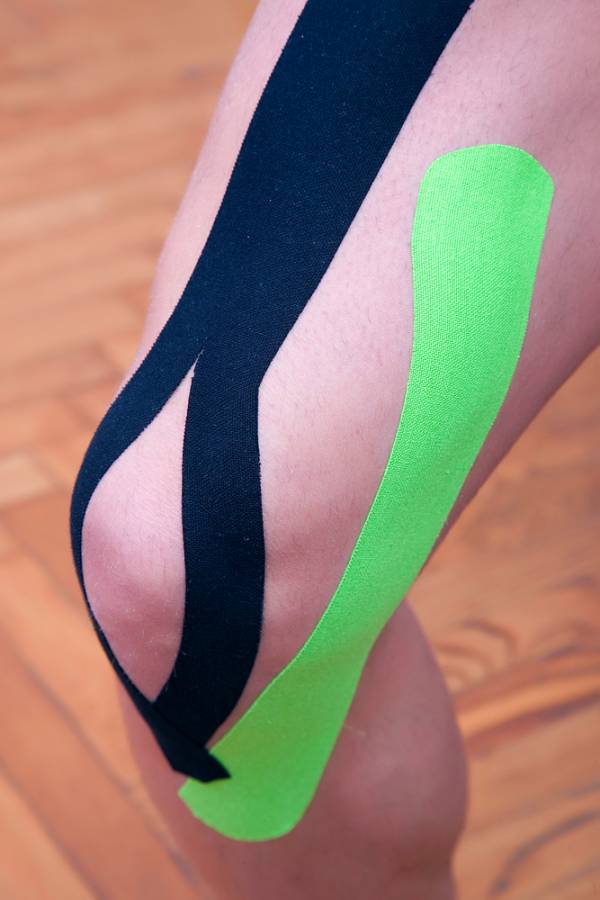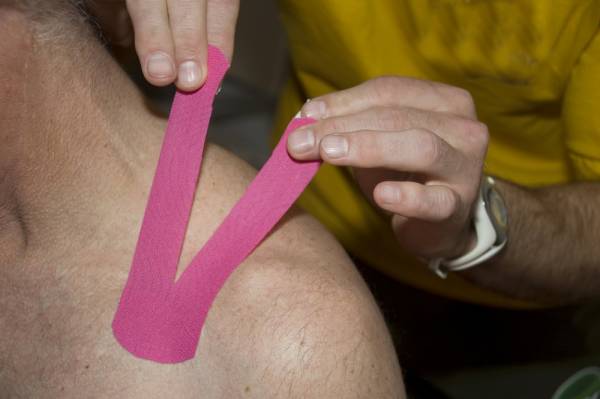Many of you have probably seen some sort of taping applications on TV of different athletes and sporting events. If you are curious, this type of taping is called Kinesio tape application method. So what may be running through your mind is, what is Kinesio tape and what is it used for?
Here’s a little back story on Kinesio tape. In Japan, Dr. Kenzo Kase first developed the Kinesio taping method in 1979. He is a chiropractor as well as a licensed acupuncturist and moxibustion therapist. Dr. Kase realized that manual therapy (i.e. massage therapy, chiropractic care, and physical therapy) was extremely effective for treatment of different ailments, but often the effects were temporary. He wanted something for his clients to use between appointment sessions to increase efficacy of manual therapy for lasting results. The Kinesio taping method was introduced to the United States in 1995, and then Europe in 1996. So it may surprise you to know that the Kinesio taping method and Kinesio Tex tape have been around for over a decade.
Many people often wonder what does Kinesio tape do and what ailments does it cover? It may help to know what Kinesio Tex tape is. Kinesio Tex tape is made of 100% elastic fibers that are latex free. You may notice a wave-like pattern, which is purposely put on the tape to mimic fingerprints and allows the tape to breathe. The tape itself only stretches on the longitudinal axis. Kinesio tape, if properly applied, can be used for virtually anything from chronic pain to menstrual cramps. For our purposes, I will specifically talk about athletes and tape usage.
Kinesio tape can be a huge asset for athletes. Kinesio tape can be applied in the middle of workouts or events in the case of sudden injury. The Kinesio tape is extremely strong and can be applied with different tension strengths. Many therapists will use different tension strengths and techniques to allow the muscles and ligaments to have “help” when injury occurs. The tape essentially stabilizes an area, for example the shoulder, to prevent any further damage.
The great thing about the Kinesio tape is that it still allows for range of motion, just not so much that you are likely to injure yourself further. In most cases, if you are in the middle of an event, the tension strength of the kinesio tape will be stronger for stabilization purposes. Now, understand that if you are in the middle of an event, Kinesio tape is just a Band-Aid. The tape will allow you to continue the event, but you must seek medical attention after your event is completed.
For Rehab
 Another important aspect of Kinesio tape for athletes is rehabilitation. Many times athletes experience that after a competitive event their body is exhausted or broken, or it may be that a non-competitive athlete has overtrained, but in either case rehab is needed. Manual manipulation is important to rehabilitation. Using Kinesio tape after a manual manipulation session can increase efficacy of your treatment more so than without Kinesio tape. The tape can help open up fascial tissue to make manual manipulation easier. It helps athletes after manual manipulation in that it gives a continuous amount of stabilization to the affected area and gives muscles and ligaments a chance to rebuild and restore by taking the pressure off of those areas that have been worked on manually.
Another important aspect of Kinesio tape for athletes is rehabilitation. Many times athletes experience that after a competitive event their body is exhausted or broken, or it may be that a non-competitive athlete has overtrained, but in either case rehab is needed. Manual manipulation is important to rehabilitation. Using Kinesio tape after a manual manipulation session can increase efficacy of your treatment more so than without Kinesio tape. The tape can help open up fascial tissue to make manual manipulation easier. It helps athletes after manual manipulation in that it gives a continuous amount of stabilization to the affected area and gives muscles and ligaments a chance to rebuild and restore by taking the pressure off of those areas that have been worked on manually.
For Alignment
The Kinesio taping method also helps with alignment. If you have a tendency to slouch or have an area of the body that is not properly aligned Kinesio tape can bring the body back into alignment and help the athlete sense how this feels in the body. Having correct alignment can decrease pain and help the joints recover from activities.
For Pain
Kinesio tape also decreases pain in certain areas of the body that may be bothersome. Most athletes tend to have lower back pain. After manual manipulation, Kinesio tape can be placed on the affected area (using a different method or style of taping depending on the area) to decrease pain and discomfort. If there is bruising or swelling, there is a taping method that helps drain fluids into the lymphatic ducts to decrease swelling and help rid the body of bruising.
For Competition
One more area that may interest athletes is that Kinesio tape can be used before a sporting event. Most athletes tend to know if they have rolling ankles or patellar tracking issues, just to name a few ailments that I routinely hear in my office. Kinesio tape can be put on the affected area to prevent injuries if the athlete plans to do an event. Using Kinesio tape before an event can save the athlete from future surgeries or ailments after the event itself.
 With Kinesio tape it is important to know that you should always go to someone who has been trained to tape through an approved CKTI (Certified Kinesio Tape Instructor), and has a background in kinesiology, anatomy, and physiology. Kinesio tape may look simple, but there are several different combination tapes and tension strengths that a person who has been trained will know how to do and do it effectively. Taping yourself is not an easy task, and even YouTube videos are not effective at teaching the methodology behind Kinesio taping. It is worth going to someone who can effectively tape you, and the longevity of the tape can be up to five days if you go to someone who has been trained in the kinesio taping method by a CKTI.
With Kinesio tape it is important to know that you should always go to someone who has been trained to tape through an approved CKTI (Certified Kinesio Tape Instructor), and has a background in kinesiology, anatomy, and physiology. Kinesio tape may look simple, but there are several different combination tapes and tension strengths that a person who has been trained will know how to do and do it effectively. Taping yourself is not an easy task, and even YouTube videos are not effective at teaching the methodology behind Kinesio taping. It is worth going to someone who can effectively tape you, and the longevity of the tape can be up to five days if you go to someone who has been trained in the kinesio taping method by a CKTI.
Your body is important to your athletic career so take care of it by going to professionals such as massage therapists, physical therapists, and chiropractors. Look for people in these profesions who have continuing education credits in the kinesio taping method by an approved CKTI. Trust me you will be glad you did.
Photo 1 courtesy of Airman 1st Class Alystria Maurer [Public domain], via Wikimedia Commons.
Photos 2 & 3 courtesy of Shutterstock.






